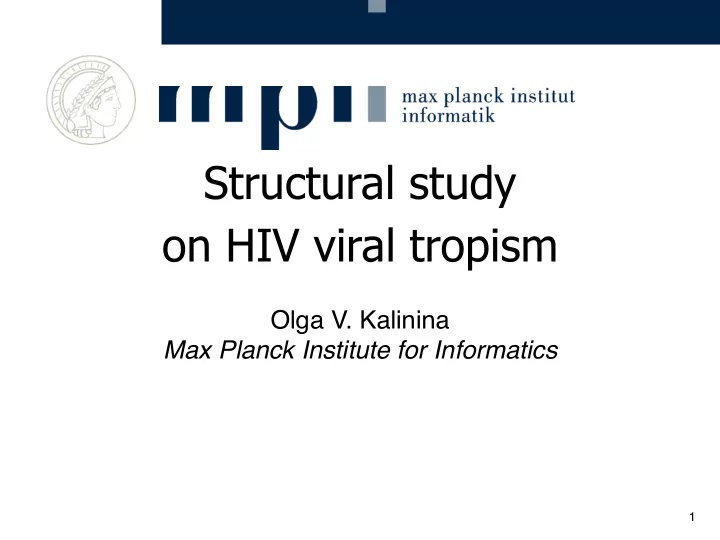

Structural study on HIV viral tropism Olga V. Kalinina Max Planck Institute for Informatics 1
Two step entry into host cell 2
Two step entry into host cell 2
Two step entry into host cell • CD4, bound by gp120 (V1 & V2 loops) • CCR5 & CXCR4, bound by gp120’s V3 loop 2
Can we predict tropism? • Tropism is largely defined by V3 loop of gp120 • Known predictors of co- receptor tropism: • 11/25 rule (positive charge at positions 11 & 25 of V3): 62% sensitivity at 5% FPR • Sequence-based SVM: 71% • Incorporating structure into SVM: up to 80% • Physico-chemical basis: unknown Sander et al., PLoS Comp Biol 2007 3
CCR5 & CXCR4 • G-protein coupled receptors (7 TM bundles, transfer extracellular signals into the cell) • Structure of CXCR4 solved in 2012 • Structure of CCR5 modelled on that template 4
Interaction between HIV’s gp120 and host receptors Wu et al., 2010 Science 5
Interaction between HIV’s gp120 and host receptors This is pure imagination! Wu et al., 2010 Science 5
Data • Experimentally verified sequences (Bozek et al., Retrovirology 2012): 7 R5 & 13 X4 • Prototypical sequences from geno2pheno-C [NGS-Sanger] (Pfeifer et al., Bioinformatics 2012): 47 R5 & 49 X4 • Prototypical sequences from geno2pheno-C [NGS-Sanger] and geno2pheno[coreceptor]: 31 R5 & 27 X4 • V3 loop structure from PDB entry 2b4c • CXCR4 structure from PDB entry 2oe0 • CCR5 structure model (33% identity, 55% positives to CXCR4) 6
Sequence comparison does not work Pfeifer & Lengauer, Bioinformatics , 2012 7
Sequence comparison does not work Pfeifer & Lengauer, Bioinformatics , 2012 Experimental Predicted R5 X4 7
What else can we measure? • Charge (recall 11/25 rule) • Statistical preferences in peptide binding ( PepSite , Trabuco et al., Nucl Acids Res 2012) • Docking energy of receptor-loop complex ( FlexPepDock , London et al., Nucl Acids Res 2011) 8
Charge R5_exp X4_exp R5_pred2 X4_pred2 R5_pred X4_pred p=0.003 p=7e-5 p=0.07 9
PepSite: how it works 10
PepSite: amino acid preferences Positively Phe charged Proline 11
PepSite: score for V3 loops 220 215 210 Experimentally tested 205 200 195 CCR5_R5 CCR5_X4 CXCR4_R5 CXCR4_X4 215 210 205 Predicted Predicted 200 w/2 methods 195 190 CCR5_R5 CCR5_X4 CXCR4_R5 CXCR4_X4 12
FlexPepDock • Protein-peptide docking protocol • Side chains and backbone of peptide flexible • Side chains of protein flexible, backbone fixed 13
FlexPepDock: results Experimentally Prediction, Prediction, tested 2 methods NGS-Sanger All-complex energy Interface energy Extremely weak difference 14
FlexPepDock: loop split in halves Left-hand half Right-hand half 15
Back to receptors CCR5 CXCR4 side top 16
Electrostatic potential CCR5 CXCR4 side top 17 -5 kT/e +5 kT/e
Endogenous ligands • CCR5: CCL5, CCL3, CCL4 (all chemokines) • CXCR4: SDF-1 (chemokine), extracellular ubiquitin 18
Ligand electrostatic potential CCR5 ligands CXCR4 ligands CCL5 SDF-1 CCL3 Ubiquitin CCL4 19 -5 kT/e +5 kT/e
Ligand electrostatic potential CCR5 ligands CXCR4 ligands Glycosylated! CCL5 SDF-1 CCL3 Ubiquitin CCL4 19 -5 kT/e +5 kT/e
Interaction model CCR5 with its ligands CXCR4 with its ligands 20
What does this imply for tropism? 21
What does this imply for tropism? • Appears to be defined by charge 21
What does this imply for tropism? • Appears to be defined by charge • Glycans often confer negative charge 21
What does this imply for tropism? • Appears to be defined by charge • Glycans often confer negative charge • There is a glycosylation site in pos 301 in 47/47 R5 and 46/49 X4 sequences, but it is not necessarily occupied 21
What does this imply for tropism? • Appears to be defined by charge • Glycans often confer negative charge • There is a glycosylation site in pos 301 in 47/47 R5 and 46/49 X4 sequences, but it is not necessarily occupied • Removal of a glycosylation site switches tropism from R5 to X4 (Pollakis et al, 2001) 21
Acknowledgements • Nico Pfeifer • Thomas Lengauer • Department for Applied Algorithmics and Computational Biology, MPII 22
Recommend
More recommend